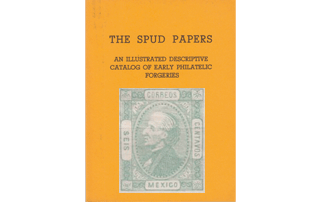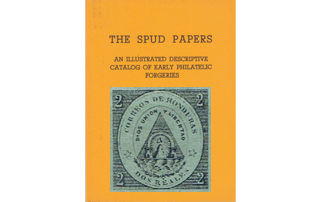Spud Papers – Paraguay
 1870, 1 Real.
1870, 1 Real.
Genuine
Engraved, on slightly yellowish white wove paper, rather thick; imperf. The lion is standing on a level piece of ground, represented by some lines of cross-shading drawn across the circle about one fourth from the bottom of the circle. His feet do not touch the boundary-line of the circle. The rest of the circle is shaded by fine horizontal lines. There are two concentric circles round the 1 in each corner, besides the boundary-line of the shading. The lion is shaded nearly all over, and his mane appears to be the darkest portion of the whole stamp. The E of REPUBLICA is properly drawn. The pole supporting the Phrygian bonnet is shaded nearly all over, and where it is not, the lines of the background can be seen through it. The postmark on my own copy of the 1 real is a double circle in blue with name (ASUNCION) and date.
Forged
Lithographed, on white wove paper, slightly thinner than the genuine; imperf. The artist has evidently failed to see that the lion is standing on the ground, for he has made it stand upon the inner line of the circle; and to balance the line which represents the horizon in the original, he has drawn other thick lines behind the lion. This will be found the easiest instant test, for the originals have only one thick line, on a level with the knees of the lion. The two concentric circles round the i in each corner merge into one before the circles are completed; or rather, the inner circle merges into the boundary-line of the shading. The E of REPUBLICA is broken and badly shaped. The face of the lion has a most ridiculous expression. He appears to be grinning, and one of his eyes is shut, and in some copies altogether absent. Over the face, and down the side of the body, are large patches destitute of shading. There is a line drawn between every two stamps on the sheet. The cancelling mark somewhat resembles our own, and is struck where two stamps meet. The colour is a more chalky rose than that of the original. Altogether, this forgery is not nearly so good as the counterfeit Cubas described above; but still there are some who might be deceived by it.
From “The Spud Papers” by Atless, Pemberton & Earée, 1871-1881.












Leave a Reply
Want to join the discussion?Feel free to contribute!